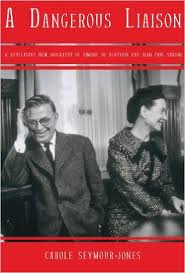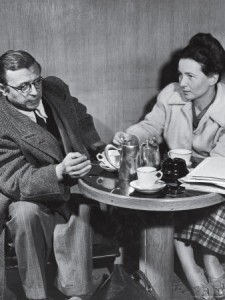 A Dangerous Liaison: A Revelatory New Biography of Simone DeBeauvoir and Jean-Paul Sartre
A Dangerous Liaison: A Revelatory New Biography of Simone DeBeauvoir and Jean-Paul Sartre
by Carole Seymour-Jones
Overlook Press. 574 pages, $35.
CAROLE SEYMOUR-JONES struggles to find a balance in this dual biography of Simone de Beauvoir and Jean-Paul Sartre between the intellectuals who risked jail for their support of Algerian independence and the couple who made compromises during the Occupation to keep their prestigious positions, then, after the war, exaggerated the extent of their roles in the Resistance. While they contributed immensely to feminism, literature, and philosophy, at the same time they could be stubborn, manipulative, and ethically dubious.
Perhaps the most distressing charge against Beauvoir is her seduction of her female lycée students, and passing them on to Sartre for him to use—a practice that the author extensively documents. Seymour-Jones also provides great detail on each of Beauvoir’s lesbian relationships, from her first, Olga Kosackiewicz, to the one involving her adopted daughter and literary executor, Sylvie Le Bon. Today she might almost be called a sexual predator, taking advantage of young, inexperienced women and casually adding them to the family of her and Sartre’s lovers, all the while overlooking the great emotional damage these women suffered.
Both Beauvoir and Sartre would use their lovers as models in their fiction, in many cases hardly bothering to conceal their identities. For instance, Kosackiewicz became the inspiration for both Xavière in Beauvoir’s She Came to Stay and Ivich in Sartre’s The Age of Reason. Beauvoir even fictionalized her relationship with the American author Nelson Algren in The Mandarins, which Algreen viewed as a betrayal. In fact, her affair with Algren was the most passionate of them all, and she would continue to wear his ring for the rest of her life.
 Beauvoir tended to be more truthful in her fiction than in her memoirs, which make no mention of her lesbian relationships. She would avoid speaking about this subject until the end of her life, claiming that she had only recently become aware of its importance. Despite her publication of The Second Sex in 1949, she would only embrace the feminist movement in the late 1960’s after realizing that her status as a single female intellectual was not the norm for most women.
Beauvoir tended to be more truthful in her fiction than in her memoirs, which make no mention of her lesbian relationships. She would avoid speaking about this subject until the end of her life, claiming that she had only recently become aware of its importance. Despite her publication of The Second Sex in 1949, she would only embrace the feminist movement in the late 1960’s after realizing that her status as a single female intellectual was not the norm for most women.
Sartre’s biggest fault, according to Seymour-Jones, was his stubborn defense of communism, which she partly attributes to his long, passionate affair with Lena Zonina, guide and interpreter during his and Beauvoir’s 1962 visit to the Soviet Union. In addition to being a literary critic, Zonina was also an agent of the KGB, ordered to seduce Sartre as a respected, famous intellectual capable of defending the Soviet Union to the West. It would take the 1968 invasion of Czechoslovakia for Sartre to understand the reality behind the illusions of the Soviet system. Until then, “being a friend of the USSR meant toeing the Party line rather than using his immense influence in the course of freedom.” He would remain committed to this position longer than his fellow intellectuals.
Seymour-Jones depicts the complexities of Beauvoir and Sartre’s open relationship, where the most important attributes were supposed to be “absolute freedom and complete openness.” While they grew so close as to finish each other’s sentences, they could still feel jealous and anxious whenever one of them was involved with someone else. Their “morganatic marriage,” as they called it, developed in 1929, after Beauvoir had rejected Sartre’s marriage proposal a second time.
In spite of the occasional jarring phrase, such as “girl-on-girl action,” A Dangerous Liaison is a well-researched, thought-provoking biography. It reveals the complex, sometimes distressing human beings behind two of the most influential philosophers and writers of the 20th century.
________________________________________________________
Charles Green is a writer based in Annapolis, Maryland.





